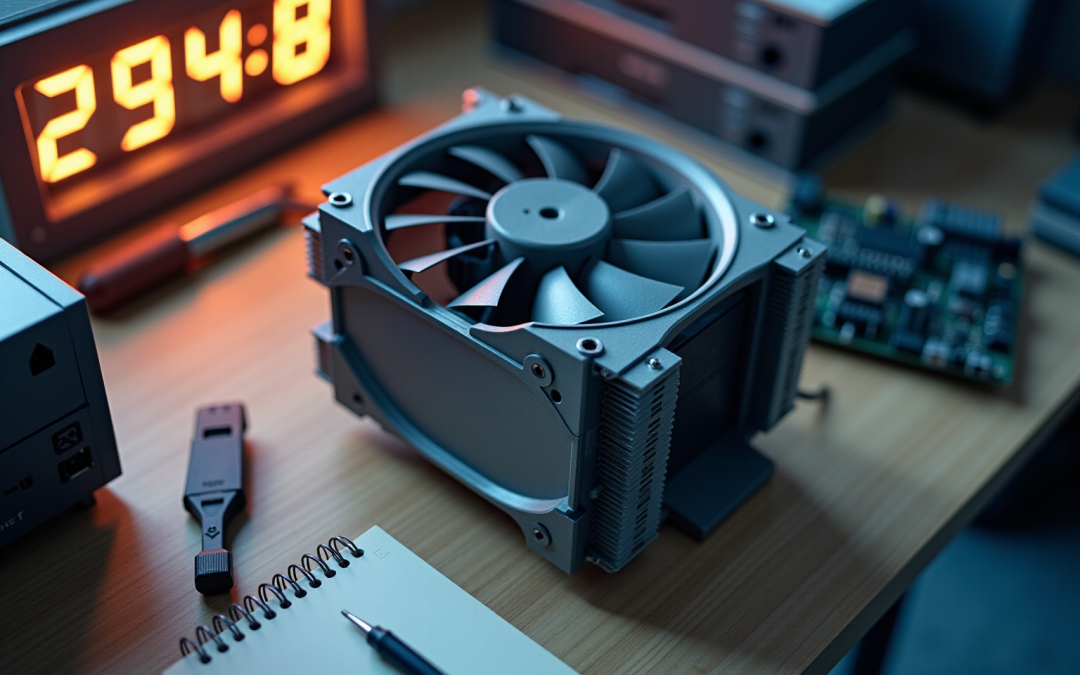Overview
The article provides a comprehensive comparison of leading cooling fans for panel applications, underscoring their critical role in temperature regulation and system reliability. It identifies essential factors such as airflow rate, noise levels, and energy efficiency, while offering insights into various brands, including Orion Fans and NMB Technologies. Each brand’s distinctive strengths are illustrated, demonstrating how they cater to specific needs within the electronics industry. This analysis not only highlights the importance of selecting the right cooling fan but also empowers readers to make informed decisions that enhance performance and reliability in their applications.
Introduction
Cooling fans are essential for maintaining optimal temperatures within electronic panels, significantly influencing the performance and longevity of devices. As technology evolves, the selection of the appropriate cooling fan has grown increasingly intricate, with numerous brands presenting distinct features and specifications tailored to various applications. Given the multitude of options available, engineers and technicians must navigate this complex landscape to make informed decisions that effectively balance efficiency, noise levels, and energy consumption.
Understanding Cooling Fans for Panel Applications
A cooling fan for panel applications is crucial in cooling devices, serving a fundamental role in temperature regulation and preventing the overheating of electronic equipment. By enhancing airflow—drawing in cooler air and expelling warmer air—these devices maintain the ideal operating conditions essential for performance and reliability. In environments where electronic components generate significant heat, selecting an appropriate cooling fan for panel can greatly influence system longevity.
Key considerations include:
- Airflow rate, typically measured in cubic feet per minute (CFM)
- Noise levels
- Energy efficiency
For example, axial fans, which commanded a 38.42% market share in 2025, are preferred for their efficient airflow design, making them well-suited for high-demand applications such as data centers and consumer electronics. Furthermore, advancements in fan technology, including IoT integration and energy-efficient designs, are transforming the landscape, facilitating real-time monitoring and optimized performance.
Engineers and technicians must prioritize components such as a cooling fan for panel to ensure the reliability and efficiency of electronic systems, as effective temperature management solutions can yield energy savings of up to 20% in new installations. As the market evolves, understanding these dynamics becomes increasingly vital for maintaining a competitive advantage in the electronics industry.
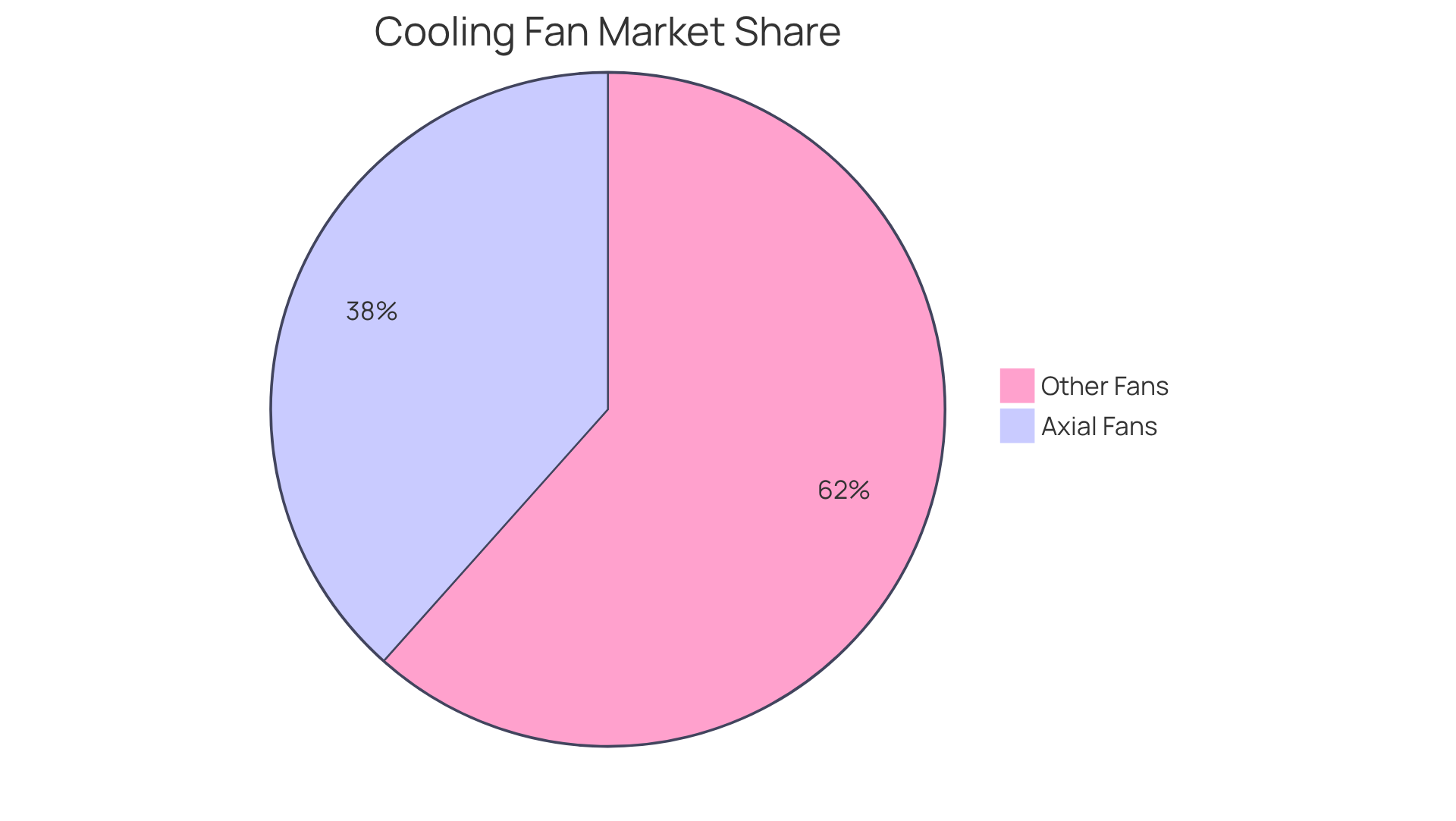
Overview of Leading Cooling Fan Brands
The cooling fan market showcases several prominent brands, each recognized for their unique strengths and product offerings:
- Orion Fans: Renowned for a comprehensive range of AC and DC fans, Orion Fans excels in delivering durable and efficient solutions tailored for industrial applications. Their unwavering commitment to quality ensures high customer satisfaction ratings, establishing them as a preferred choice in the industry. Recent feedback highlights that customers consistently praise Orion Fans for their reliability and performance in demanding environments.
- NMB Technologies: This brand stands out for its high-performance devices that seamlessly integrate advanced technology with energy efficiency. NMB Technologies’ products are ideal for a variety of electronic applications, with case studies demonstrating successful implementations across multiple sectors, showcasing their effectiveness in real-world scenarios. An industry leader noted, “NMB Technologies consistently delivers innovative solutions that meet the evolving needs of our clients.”
- Trumaxx: Acknowledged for providing cost-efficient solutions, Trumaxx offers dependable fans suitable for both commercial and industrial requirements. Their focus on affordability does not compromise performance, making them a viable option for budget-conscious projects. Customer reviews underscore their value for money and dependable operation.
- ACDC Fan: Specializing in energy-efficient designs, ACDC Fan emphasizes innovative technology that reduces power consumption while ensuring high airflow. Their products are increasingly favored among engineers seeking sustainable temperature regulation solutions. Recent product launches have further bolstered their reputation in the market.
- Kooltronic: Offering a diverse range of enclosure cooling devices, including a cooling fan for panel, Kooltronic is recognized for its sturdy construction and dependability, particularly in challenging conditions. Their supporters are designed to endure tough environments, guaranteeing reliable performance. User responses indicate a for Kooltronic devices in essential applications.
Collectively, these brands embody a spectrum of choices for engineers and technicians, each providing valuable solutions within the fan market.
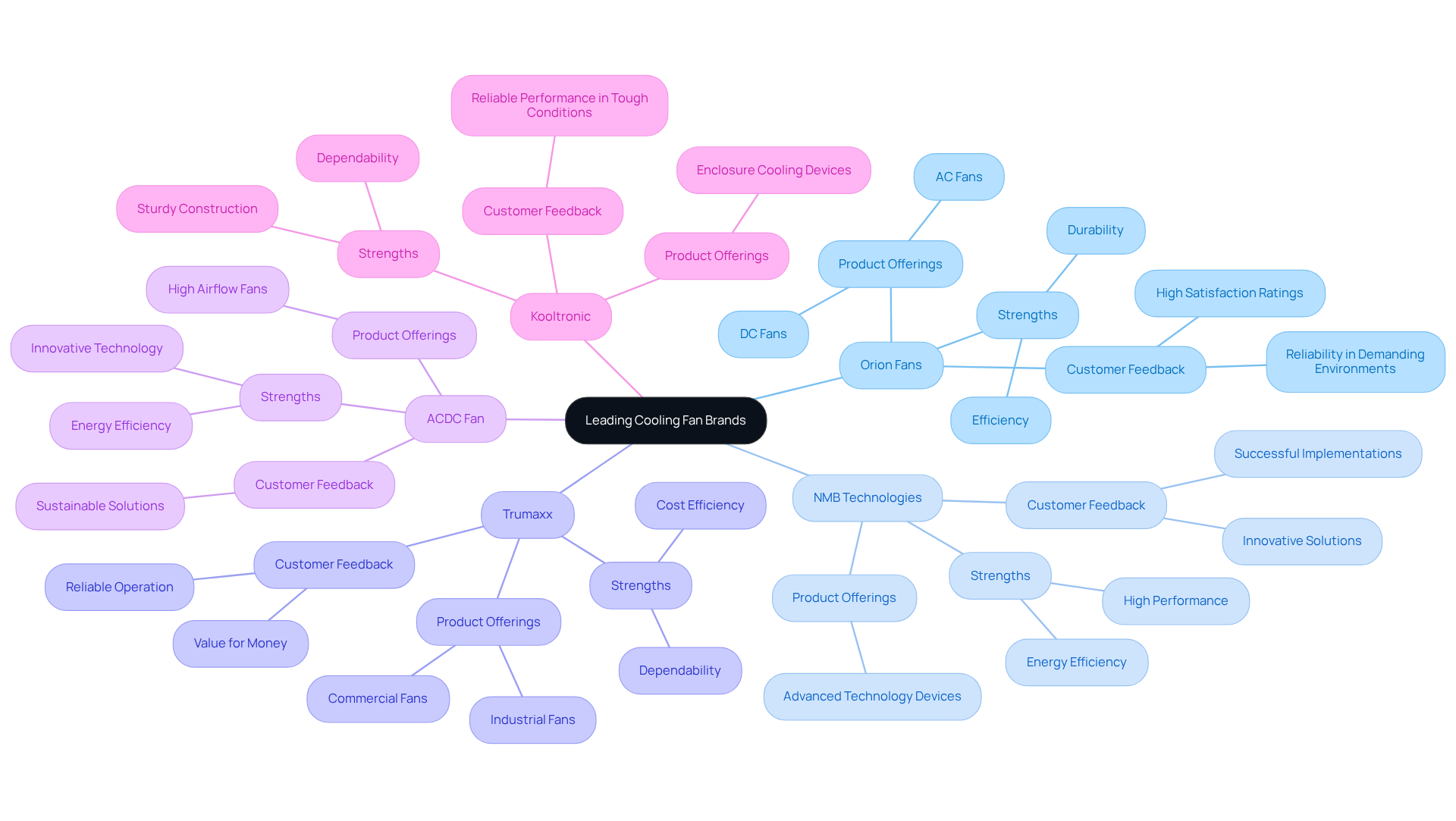
Comparative Analysis of Features and Specifications
When evaluating cooling fans for panel applications, several essential specifications must be taken into account:
- Airflow (CFM): This metric measures the volume of air a fan can move, with higher CFM ratings being crucial for cooling larger panels or densely packed components. Gagner-Toomey Associates provides a wide range of DC input Tube Axial units, with dimensions varying from 15 to 280mm, enhanced for effectiveness and efficiency, serving various uses.
- Static Pressure: Understanding static pressure is vital as it indicates the fan’s ability to overcome resistance in the system. A balance between airflow and static pressure is essential for efficient cooling performance, particularly when a cooling fan for panel is used in scenarios with limited airflow routes. Gagner-Toomey’s centrifugal blowers, available in sizes from 15 to 225mm, are designed to meet these demands.
- Noise Level (dBA): Noise is a significant consideration, particularly in environments requiring quiet operation. Gagner-Toomey’s supporters are optimized for low noise, making them suitable for sensitive applications where sound levels must be minimized.
- Power Consumption (Watts): Energy efficiency is increasingly vital in fan design. Gagner-Toomey’s EC devices and blowers, varying in dimensions from 120 to 910mm, are designed to reduce power consumption while enhancing airflow, attracting environmentally aware engineers.
- Size and Mounting Options: The physical dimensions and mounting configurations of fans can influence installation ease. Gagner-Toomey provides a variety of sizes and custom designs for a cooling fan for panel, ensuring compatibility with different panel configurations and applications.
- Durability and Environmental Ratings: Many of Gagner-Toomey’s products come with IP protection ratings, indicating their suitability for harsh environments, which is essential for industrial applications.
- Operating Temperature and Thermal Limits: Determining the ideal operating temperature and thermal limits of the device is essential for choosing the suitable fan, ensuring optimal functioning and durability. Gagner-Toomey’s thermal management solutions, including extruded aluminum heatsinks, copper-based heat sinks, and liquid temperature control options, support these requirements.
- Fan Configurations: Taking into account fan arrangements, such as parallel or series setups, can improve airflow and pressure performance, satisfying particular thermal specifications according to the needs of the use case. Gagner-Toomey’s integrated temperature regulation solutions, which combine fans, heat pipes, and radiators, provide tailored options for complex thermal challenges.
This comparative analysis underscores how the offerings from Gagner-Toomey Associates align with the specific needs of engineers and technicians in the electronics sector, particularly when compared to other brands that may not offer the same breadth of .
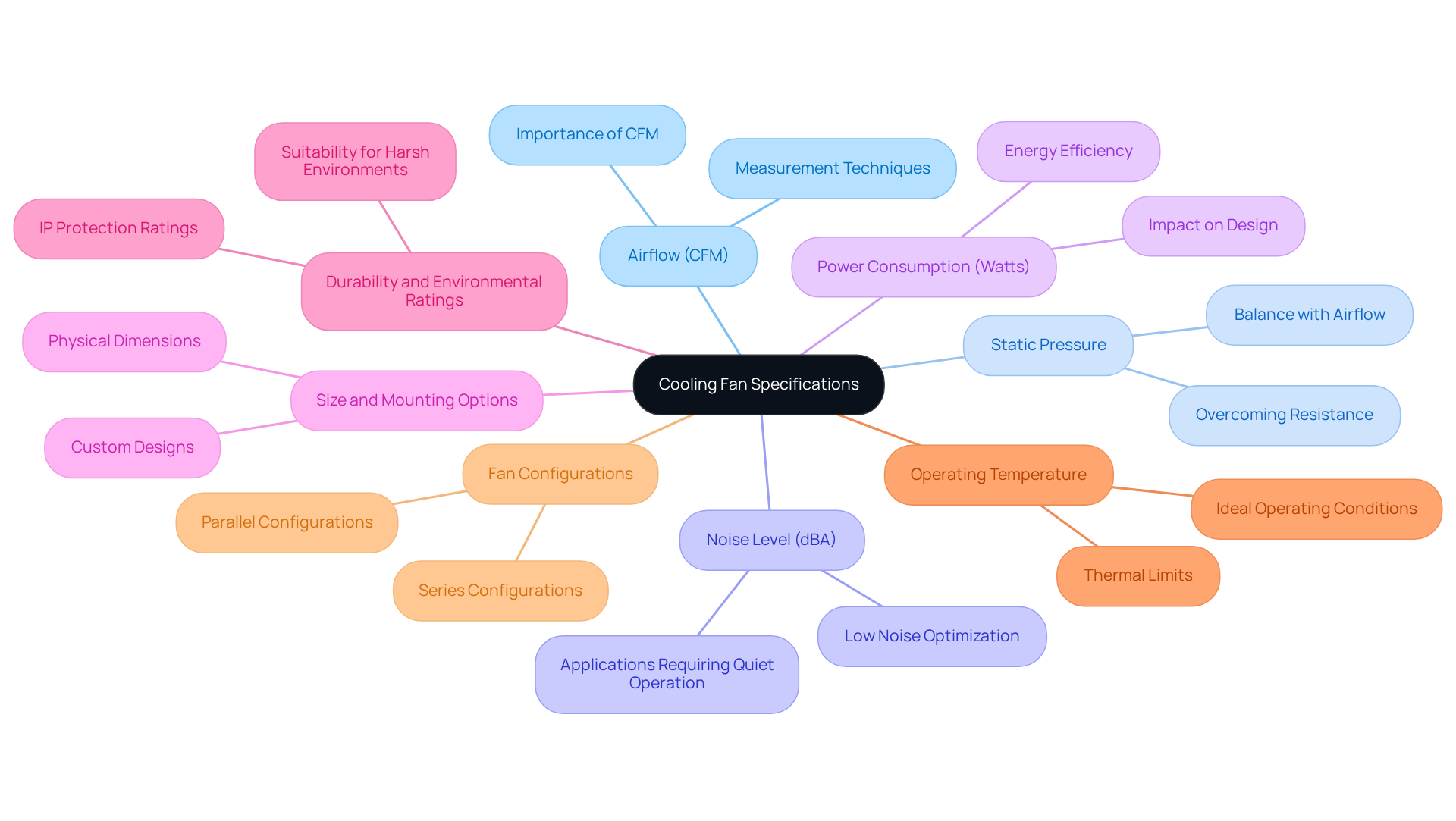
Evaluating Pros and Cons of Each Brand
Evaluating the advantages and disadvantages of leading cooling fan for panel brands yields critical insights for engineers.
-
Orion Fans:
- Pros: Offers a wide range of products, features robust construction, and is suitable for industrial applications.
- Cons: Comes with a higher price point compared to some competitors.
-
NMB Technologies:
- Pros: Known for low noise levels, high energy efficiency, and reliable performance.
- Cons: Limited options available for high-CFM models.
-
Trumaxx:
- Pros: Provides cost-effective solutions and good performance for general applications.
- Cons: May lack the advanced features found in premium brands.
-
ACDC Fan:
- Pros: Recognized for excellent energy efficiency and innovative designs.
- Cons: Availability may be limited in certain regions.
-
Kooltronic:
- Pros: Durable and reliable, with an extensive selection of enclosure fans.
- Cons: Some models may be bulkier, requiring more installation space.
This evaluation empowers engineers to carefully based on specific project requirements and budget constraints.
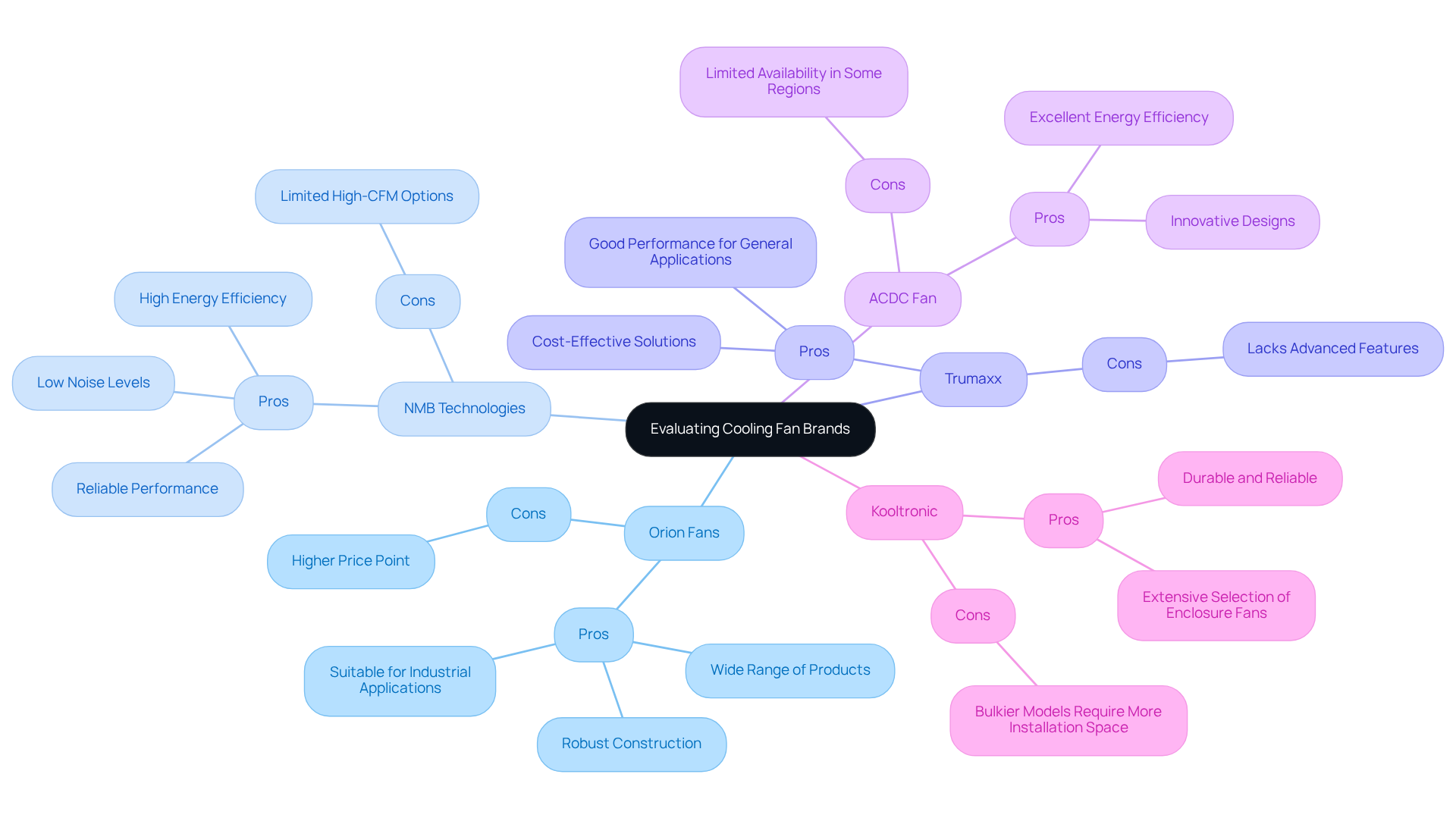
Conclusion
Selecting the right cooling fan for panel applications is paramount for ensuring optimal performance and longevity of electronic devices. Understanding the various factors that influence fan effectiveness, such as airflow rates and energy efficiency, is essential. This knowledge empowers engineers and technicians to make informed decisions tailored to their specific needs.
Key considerations including airflow (CFM), noise levels, and durability have been thoroughly examined, highlighting the strengths and weaknesses of leading brands such as:
- Orion Fans
- NMB Technologies
- Trumaxx
- ACDC Fan
- Kooltronic
Each brand presents unique advantages, addressing different requirements and budget constraints, thus enabling users to select the most suitable cooling solution for their applications.
As technology surrounding cooling fans continues to advance, it is crucial to remain informed about the latest developments and market trends. Engineers must prioritize effective cooling solutions while also considering the broader implications of energy efficiency and environmental sustainability. By making educated choices in cooling fan selection, professionals can enhance system reliability and contribute to a more sustainable future in electronics.
Frequently Asked Questions
What is the purpose of a cooling fan for panel applications?
A cooling fan for panel applications is essential for regulating temperature and preventing the overheating of electronic equipment by enhancing airflow, drawing in cooler air, and expelling warmer air.
Why is selecting the right cooling fan important?
Selecting the appropriate cooling fan is crucial because it can significantly influence the longevity and reliability of electronic systems, especially in environments where components generate significant heat.
What key considerations should be taken into account when choosing a cooling fan?
Key considerations include airflow rate (measured in cubic feet per minute or CFM), noise levels, and energy efficiency.
What type of cooling fan has a significant market share and why?
Axial fans, which held a 38.42% market share in 2025, are preferred for their efficient airflow design, making them suitable for high-demand applications like data centers and consumer electronics.
How is technology changing the cooling fan market?
Advancements in fan technology, including IoT integration and energy-efficient designs, are transforming the market by facilitating real-time monitoring and optimized performance.
What benefits can effective temperature management solutions provide?
Effective temperature management solutions can yield energy savings of up to 20% in new installations, enhancing the efficiency and reliability of electronic systems.
Why is understanding cooling fans increasingly vital in the electronics industry?
As the market evolves, understanding the dynamics of cooling fans becomes essential for maintaining a competitive advantage in the electronics industry.

